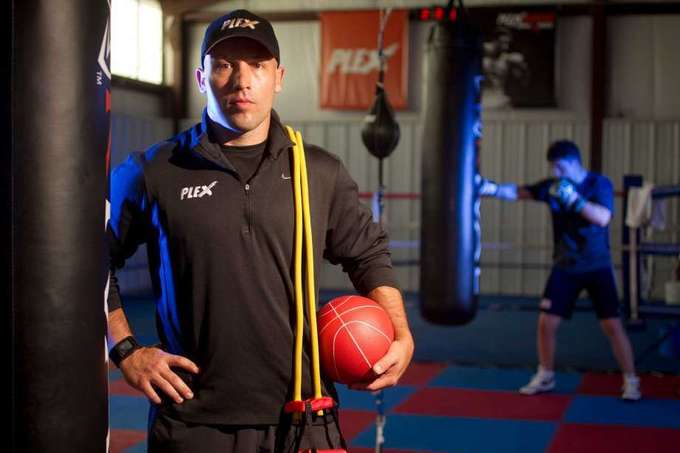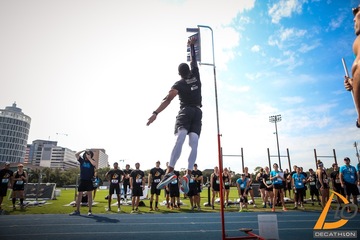Prep Like a Pro: The Vertical Jump
July 29, 2018
 At his Plex facility in Houston, Danny Arnold has trained numerous NFL All-Pros, Hall of Famers, and First-Round Draft Picks, including Charles Woodson, Julius Peppers, Casey Hampton, Wes Welker, and Jadeveon Clowney. Widely recognized as the world's leading expert in NFL Combine preparation, Danny has generously agreed to share his training tips for The D10's Combine-style events with our community.
At his Plex facility in Houston, Danny Arnold has trained numerous NFL All-Pros, Hall of Famers, and First-Round Draft Picks, including Charles Woodson, Julius Peppers, Casey Hampton, Wes Welker, and Jadeveon Clowney. Widely recognized as the world's leading expert in NFL Combine preparation, Danny has generously agreed to share his training tips for The D10's Combine-style events with our community. The Vertical Jump is the Combine event where you can "cheat" the least. You can't beat the system here.
Still, every inch matters. Do these five things to make sure you're not giving away an inch here or there.
Get Your Rhythm Down
If you want to test pure athletic ability, most will argue the Vertical Jump is the way to do it. Your plyometric exercises are going to build your explosion and fast-twitch muscle fiber. You'll get out what you put in. Beyond that, there isn't much we can do techniques-wise to transform the athlete's result, other than helping the athlete understand his or her own rhythm.
You're going to rock into the explosion of your jump, up and down, up and down.
You have to do it over and over and pay close attention to the rhythm that works best for your particular body.
Get Your Rhythm Down
If you want to test pure athletic ability, most will argue the Vertical Jump is the way to do it. Your plyometric exercises are going to build your explosion and fast-twitch muscle fiber. You'll get out what you put in. Beyond that, there isn't much we can do techniques-wise to transform the athlete's result, other than helping the athlete understand his or her own rhythm.
You're going to rock into the explosion of your jump, up and down, up and down.
You have to do it over and over and pay close attention to the rhythm that works best for your particular body.
Videotape Yourself
You want to videotape yourself practicing.
You only need to twist your body a little bit.
If you're not landing in the exact same spot you took off, you're twisting too much.
Have a marker on the floor. Come down where you took off.
Look at your form on the video to see where you're exerting unnecessary energy and movement on the way up.
You only need to twist your body a little bit.
If you're not landing in the exact same spot you took off, you're twisting too much.
Have a marker on the floor. Come down where you took off.
Look at your form on the video to see where you're exerting unnecessary energy and movement on the way up.
Find Your Reach Point
Your hand doesn't have to be up the entire time you're in the air.
If you pulled your hand out a little too soon, you broke the momentum of your jump.
If you waited too long, you hit the marker when you were already coming down.
Either way, you're losing an inch.
You have to time it just right.
If you pulled your hand out a little too soon, you broke the momentum of your jump.
If you waited too long, you hit the marker when you were already coming down.
Either way, you're losing an inch.
You have to time it just right.

Touch Lightly
One way people twist too much and waste energy is by cranking their shoulder to hammer the Vertec.
Barely touching a marker counts the same as swatting the crap out of it. I've almost never seen a touch not count, so don't try to overdo it.
Your First Jump Should Be Your Second
A lot of guys make this mistake: they don't do an all-out jump on the side before their first official attempt.
They warm up, but then they're scared to waste energy.
That goes for the Bench Press and the 40, all right, but it doesn't apply to the Vertical Jump.
Think about it: Why do you do better on the second jump 99% of the time? It's because you didn't exert yourself to the maximum getting warm before your first one.
So get a full blown-out Vertical in right before your first scored jump.
They warm up, but then they're scared to waste energy.
That goes for the Bench Press and the 40, all right, but it doesn't apply to the Vertical Jump.
Think about it: Why do you do better on the second jump 99% of the time? It's because you didn't exert yourself to the maximum getting warm before your first one.
So get a full blown-out Vertical in right before your first scored jump.
If you're doing it correctly, there should be no difference in explosion between your first and second jumps.
The second's just a chance to repair a flaw in your technique.
The second's just a chance to repair a flaw in your technique.